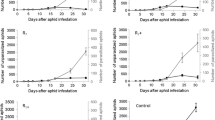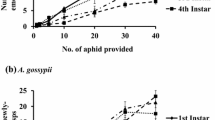Abstract
Several braconid and aphelinid parasitoids, midges, lacewings, and ladybird beetles are used to control aphids in greenhouses. Here, I review three topics as ecological bases for the biological control of aphids in a protected culture: the preliminary evaluation of biological control agents, natural enemy release strategies, and the effects of intraguild predation (IGP) on biological control. A comparison of several parasitoid species was conducted to select agents for the biological control of aphids; the intrinsic rate of natural increase was a useful criterion in the preliminary evaluation. To compare predators as biological control agents, the aphid-killing rate must be considered as a critical criterion, rather than reproductive criteria. The banker plant system (open rearing system) is used as a release method for Aphidius colemani and other natural enemies of aphids. Continuous release of parasitoid adults, which is the important characteristic of this method, has a stabilizing effect on population fluctuation in the aphid–parasitoid system. Two species of natural enemies can be used to control aphids in greenhouses. When one parasitoid and one predator are used simultaneously in a greenhouse, IGP of the parasitoid by the predator can occur, but the effect of IGP is less important in greenhouses than in the field.
Similar content being viewed by others
References
Bennison JA (1992) Biological control of aphids on cucumbers: use of open rearing systems or “banker plants” to aid establishment of Aphidius matricariae and Aphidoletes aphidimyza. Med Fac Landbouww Univ Gent 57/2b:457–466
Bennison JA, Corless SP (1993) Biological control of aphids on cucumbers: further development of open rearing units or “banker plants” to aid establishment of aphid natural enemies. IOBC/WPRS Bull 16(2):5–8
Birch LC (1948) The intrinsic rate of natural increase of an insect population. J Anim Ecol 17:15–26
Blümel S (2004) Biological control of aphids on vegetable crops. In: Heinz KM, van Driesche RG, Parrella MP (eds) Biocontrol in protected culture. Ball Publishing, Batavia, pp 297–312
Brodeur J, Cloutier C, Gillespie D (2002) Higher-order predators in greenhouse systems. IOBC/WPRS Bull 25(1):33–36
Chau A, Heinz KM (2004) Biological control of aphids on ornamental crops. In: Heinz KM, van Driesche RG, Parrella MP (eds) Biocontrol in protected culture. Ball Publishing, Batavia, pp 277–295
Christensen RK, Enkegaard A, Brodsgaard HF (2002) Intraspecific interactions among the predators Orius majusculus and Aphidoletes aphidimyza. IOBC/WPRS Bull 25(1):57–60
Dixon AFG (2000) Insect predator–prey dynamics. Cambridge University Press, Cambridge
Enkegaard A, Christensen RK, Brodsgaard HF (2005) Interspecific interactions among the aphid parasitoid Aphidius colemani and the aphidophagous gallmidge Aphidoletes aphidimyza. IOBC/WPRS Bull 28(1):83–86
Gutierrez AP (1992) Physiological basis of ratio-dependent predator–prey theory: the metabolic pool model as a paradigm. Ecology 73:1552–1563
Gutierrez AP, Baumgaertner JU, Summers CG (1984) Multitrophic models of predator–prey energetics. Can Entomol 116:923–963
Gutierrez AP, Hagen KS, Ellis CK (1990) Evaluating the impact of natural enemies: a multitrophic perspective. In: Mackauer M, Ehler LE, Roland J (eds) Critical issues in biological control. Intercept, Andover, pp 81–107
Hansen LS (1983) Introduction of Aphidoletes aphidimyza (Rond.) (Diptera: Cecidomyiidae) from an open rearing unit for the control of aphids in glasshouses. IOBC/WPRS Bull 6(3):146–150
Hawkins B, Cornell HV (2001) Theoretical approaches to biological control. Cambridge University Press, Cambridge
van Lenteren JC (1986) Parasitoids in the greenhouse: successes with seasonal inoculative release systems. In: Waage J, Greathead D (eds) Insect parasitoids. Academic, London, pp 341–374
van Lenteren JC (1995) Integrated pest management in protected crops. In: Dent DR (ed) Integrated pest management: principles and systems development. Chapman Hall, London, pp 311–343
van Lenteren JC, Manzaroli G (1999) Evaluation and use of predators and parasitoids for biological control of pests in greenhouses. In: Albajes R, Gullino MA, van Lenteren JC, Elad Y (eds) Integrated pest and disease management in greenhouse crops. Kluwer, Dordrecht, pp 183–201
van Lenteren JC, Woets J (1988) Biological and integrated pest control in greenhouses. Annu Rev Entomol 33:239–269
Meyling NV, Brodsgaard HF, Enkegaard A (2002) Intraguild predation between the predatory flower bug, Anthocoris nemorum, and the parasitoid, Aphidius colemani. IOBC/WPRS Bull 25(1):189–192
Rabasse JM, Wyatt IJ (1985) Biology of aphids and their parasites in greenhouses. In: Hussey NW, Scopes N (eds) Biological pest control: the glasshouse experience. Blandford Press, Poole, pp 66–73
Rabasse JM, van Steenis MJ (1999) Biological control of aphids. In: Albajes R, Gullino, MA, van Lenteren JC, Elad Y (eds) Integrated pest and disease management in greenhouse crops. Kluwer, Dordrecht, pp 235–243
van Rijn PCJ, Mollema C, Steenhuis-Broers GM (1995) Comparative life history studies of Frankliniella occidentalis and Thrips palmi (Thysanoptera: Thripidae) on cucumber. Bull Entomol Res 85:285–297
Rose MR (1987) Quantitative ecological theory. Croom Helm, London
Rosenheim JA, Kaya HK, Ehler LE, Marois JJ, Jaffee BA (1995) Intraguild predation among biological-control agents: theory and evidence. Biol Control 5:303–335
Sabelis NM, van Rijn PCJ (1997) Predation by insects and mites. In: Lewis T (ed) Thrips as crop pests. CAB International, Wallingford, pp 259–354
Sapoukhina N, Tyutyunov Y, Arditi R (2003) The role of prey taxis in biological control: a spatial theoretical model. Am Nat 162:61–76
van Steenis MJ (1992) Biological control of the cotton aphid, Aphis gossypii Glover (Hom., Aphididae): pre-introduction evaluation of natural enemies. J Appl Entomol 114:362–380
van Steenis MJ (1993) Intrinsic rate of natural increase of Aphidius colemani Vier. (Hym., Braconidae), a parasitoid of Aphis gossypii Glov. (Hom., Aphididae), at different temperatures. J Appl Entomol 116:192–198
van Steenis MJ (1994) Intrinsic rate of natural increase of Lysiphlebus testaceipes Cresson (Hymenoptera: Braconidae), a parasitoid of Aphis gossypii Glov. (Homopetra., Aphididae), at different temperatures. J Appl Entomol 118:399–406
van Steenis MJ (1995) Evaluation of four aphidiine parasitoids for biological control of Aphis gossypii. Entomol Exp Appl 75:151–157
van Steenis MJ, El-Khawass KAMH (1995) Life history of Aphis gossypii on cucumber: influence of temperature, host plant and parasitism. Entomol Exp Appl 76:121–131
Tommasini MG (2003) Evaluation of Orius species for biological control of Frankliniella occidentalis (Pergande) (Thysanoptera: Thripidae). PhD dissertation, Wageningen University, The Netherlands
Waage J (1990) Ecological theory and the selection of biological control agents. In: Mackauer M, Ehler LE, Roland J (eds) Critical issues in biological control. Intercept, Andover, pp 135–157
Wyatt IJ, Brown SJ (1977) The influence of light intensity, daylength and temperature on increase rates of four glasshouse aphids. J Appl Ecol 14:391–399
Yano E (1989a) A simulation study of population interaction between the greenhouse whitefly, Trialeurodes vaporariorum (Westwood) (Homoptera: Aleyrodidae), and the parasitoid Encarsia formosa Gahan (Hymenoptera: Aphelinidae). I. Description of the model. Res Popul Ecol 31:73–88
Yano E (1989b) A simulation study of population interaction between the greenhouse whitefly, Trialeurodes vaporariorum (Westwood) (Homoptera: Aleyrodidae), and the parasitoid Encarsia formosa Gahan (Hymenoptera: Aphelinidae). II. Simulation analysis of population dynamics and strategy of biological control. Res Popul Ecol 31:89–104
Acknowledgments
I thank Prof. Yoshimi Hirose of Kyushu University, Prof. Hironori Yasuda of Yamagata University, and the others responsible for organizing the International Symposium on Biological Control of Aphids and Coccids.
Author information
Authors and Affiliations
Corresponding author
Rights and permissions
About this article
Cite this article
Yano, E. Ecological considerations for biological control of aphids in protected culture. Popul Ecol 48, 333–339 (2006). https://doi.org/10.1007/s10144-006-0008-2
Received:
Accepted:
Published:
Issue Date:
DOI: https://doi.org/10.1007/s10144-006-0008-2




